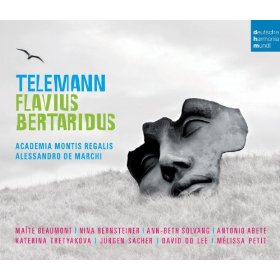Telemann composed more than 40 works for the opera house in Hamburg, and Flavius Bertaridus, debuted in November, 1729, is the only one of his opera serie to survive. The respected theorist, composer, and diplomat Johann Mattheson, a major figure in Hamburg’s musical scene (now famous primarily for almost killing Handel in a duel), in an attempt to make opera- going a “better” moral experience, had delivered an edict that opera serie should have no comic characters. Flavius was one of the results. In addition, Telemann composed the “informational” recits and arias in German and the emotion-laden arias in Italian. Hamburg was the center of the Hanseatic League, and the comings-and-goings of many nationalities was far greater than in almost any other German city, so the entire undertaking makes a certain amount of sense.
The score, as “rediscovered” in 2005, was lacking much of the instrumentation; conductor Alessandro de Marchi, aware of the forces on hand at the Hamburg Theater in 1729, has re-created what probably was heard there: a bevy of wind instruments, including recorders, flutes, bassoons, and oboes, as well as theorbos, trumpets, drums, and a pair of harpsichords. The result is colorful, varied, and fascinating, and a very good guess as to what the audiences heard then.
Sharp-eyed readers may note immediately that the plot is similar to that of Handel’s Rodelinda, but with added bewilderments: the title character (called Bertarido in Handel but hereafter referred to as FB) is the King of the Lombards, in exile after the tyrant Grimoaldo has killed his brother and usurped the throne. FB and Rod have a son named Cunibert; he and Rod are being held captive by Grim while hubby has disappeared. Grim is married to FB’s sister, Flavia; they are the parents of Regimbert; Grim is nasty to both his wife and child. Orontes is one of Grim’s generals; he loves Flavia, who despises him but eventually marries him after Grim is killed in order to save her son. There are other complications: Rod thinks she’s about to kill Grim at the close of Act 2 but accidentally wounds FB; she then tries again but winds up injuring Orontes. Onulfus is a diplomat who would like to see Grim overthrown. It isn’t too hard to follow, and the music is invariably appealing and has a unique stamp. If only Rodelinda and Cunibert didn’t disguise themselves and change their names to “Niso” and “Lucinda” halfway through.
The arias—and there are dozens of them—range from the simple for the two children (especially the lovely Katerina Tretyakova as Cunibert, whose “Geliebte Vater” is charming) to the virtuosic for FB, sung here by mezzo Maite Beaumont, a quite sensational, warm-toned singer. (A mezzo took the role in 1729 as well.) She impresses in a quiet way in Act 1 with FB’s entrance aria upon returning, disguised, to his homeland with “Cari lidi” (with bassoon obbligato), and with a martial tune in Act 2 (“Fa pur guerra”) with trumpets and drums.
Rodelinda is sung by soprano Nina Bernsteiner, who gets off to a rough start but eventually warms to the role; she is stunning in her duet with Beaumont in Act 2 and in her “vendetta” aria a few minutes later. Antonio Abete’s Grimoaldo also gets stronger as he goes along, and really takes the floor in his rousing Act 2 duet with Beaumont despite the fact that his role is a mustache-twirling villain. Ann-Beth Solvang, a mezzo, is Flavia, and she is fine in her (almost obligatory in Baroque opera) nightingale aria (with toodling recorder) at the start of Act 2. Countertenor David DQ Lee is a potent Onulfus, with spotless coloratura and a fearless delivery, but Jürgen Sacher, as the wicked Orontes, sings crudely.
Alessandro de Marchi leads the superb Academia Montis Regalis in a confident, crisp reading that makes the most of Telemann’s amazingly rich orchestration and choral episodes. This is an important release; it may not be a masterpiece on a Mozartean level, but it introduces listeners to a unknown aspect of Georg Philip Telemann and provides a missing link in Baroque opera. The sonics—I believe it was recorded live over a period of four nights at performances in Innsbruck—are very good. A rarity for some; a necessity for others.
































